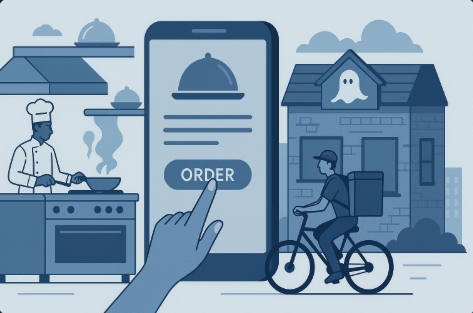You order dinner from your phone. It says the burger is from a restaurant across town. But that place doesn’t exist. There is no dining area, sign out front, or waiters. Just a name on an app and a rented kitchen behind a gas station. That’s not a glitch as it’s the new way food is made and sold.
Ghost kitchens and virtual brands are reshaping meals, deliveries, and even how we think about restaurants. You don’t see it happening. But it’s there and it’s growing fast. Let’s pull the curtain back and see who’s really feeding us now.
How Food Went Invisible and Why It Stuck
Restaurants used to be loud, bright places with music, tables, and menus. You could smell the fries before you walked in. Now, meals show up on doorsteps without a hint of where they came from. This shift didn’t start by accident as it’s part of a new system built on speed, cost, and clicks. Below are the pieces that explain how invisible kitchens and digital-only brands are changing food from plate to phone.
1. What Is a Ghost Kitchen, Really?
A ghost kitchen makes food for delivery apps only. It doesn’t need to be pretty. It just needs to cook. These places are often hidden in:
- Warehouses
- Parking lots
- Shared kitchens
- Empty malls
They rent space, pay less for décor and they don’t worry about foot traffic. That’s the whole idea.
Some ghost kitchens cook for one brand while others run 10 or more from the same spot. The food goes into bags, not onto plates and it never touches a tablecloth.
2. Virtual Brands: Names Without Places
You scroll through a food app. You see a menu from “Wing Explosion” or “Taco Power.” Sounds legit. But neither has a building. They’re virtual brands.
These are online-only restaurants. Their menus live on apps and their food comes from ghost kitchens or from regular restaurants making extra money on the side. So one kitchen could cook meals for:
- A burger brand
- A sushi brand
- A pasta brand
It done all at once with the same staff and same space, but with different labels. The customer doesn’t know and most don’t care as long as the food’s hot and tasty.
3. Why Customers Keep Coming Back
Virtual brands offer wild menus. Crazy burgers, overloaded shakes, chicken sandwiches stacked with heat, and a lot more. They’re made for scrolling, tapping, and sharing.
And people love them because delivery feels fast and prices stay low. In addition to that, new brands pop up often. One reason these places grow so fast is because apps let them test menus without risk. If people stop ordering, they just rebrand and start again.
4. The Platforms That Make It All Work
Food delivery isn’t magic, it’s software. Apps like Uber Eats, DoorDash, and Grubhub power most of the action. They list the brands, track the drivers, and handle payments. These apps also push what they want you to buy. They highlight deals and feature certain brands. All of this shapes what people eat.
Some restaurants now build virtual brands just to show up more often in the app. One kitchen. Five logos. All showing up in search. If you’re wondering which platforms host the best (or worst) virtual food brands, TrustFeed.io can help you see who’s doing what and how people feel about it.
5. Big Chains Are In On It Too
Ghost kitchens aren’t just for new brands as big players have joined in. Chains like Wendy’s, Chili’s, and Applebee’s now run virtual brands from their real kitchens. They cook extra items under new names. As a result, it leads to more orders and less overhead due to use of extra kitchen space
You could order wings from “Cosmic Chicken Club” and not realize they came from the same Applebee’s down the block. Chains aren’t hiding, they’re being smart. They use fake names to grab more eyeballs and boost sales. It’s food marketing by disguise. This goes to show it is beoming more of a trend as more and more people are using ghost kitchens for freater efficiency.
Conclusion
You eat it and rate it, then you forget it and that’s the ghost kitchen deal. But behind those fries and wings, big shifts are happening. Real places are fading and digital menus are taking over. The food still fills your belly. But the story behind it? That part’s disappearing fast.
Cities are starting to ask some questions. Some places now require ghost kitchens to share their location or name their operators while others are watching food safety more closely. Still, for now, most ghost kitchens live in the shadows. As long as the food shows up, few people ask how it got there.
